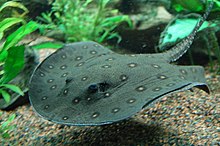Peacock stingray
| Peacock stingray | ||||||||||||
|---|---|---|---|---|---|---|---|---|---|---|---|---|

Peacock stingray ( Potamotrygon motoro ) |
||||||||||||
| Systematics | ||||||||||||
|
||||||||||||
| Scientific name | ||||||||||||
| Potamotrygon motoro | ||||||||||||
| ( Müller & Henle , 1841) |
The peacock stingray ( Potamotrygon motoro ) belongs to the family of freshwater stingrays .
Appearance
The peacock stingrays can grow up to 80 cm in diameter. The males have thick swellings on the pelvic fins, usually remain a bit smaller and are more contrasting in color than the females.
They have a poison sting on their tail, the poison of which is very dangerous; even scratches are painful. If you step on a ray buried in the sand, it will flap its tail. As a result, there are thousands of accidents in South America every year that can be fatal for young children. For this reason, they are more feared among the population than the piranhas .
habitat
Their habitat is the great rivers of South America , especially the Amazon and Orinoco .
Way of life

Depending on their age, the rays are diurnal and / or nocturnal and dig through the river bed for worms , small crabs , snails , mussels and fish .
At night they seek out shallow areas of the bank and bury themselves until the next morning. Young rays often burrow in during the day and only look for food under cover of dusk.
Reproduction
After a gestation period of around three to four months, the viviparous rays give birth to between 1 and 12 fully developed young with a body diameter of 6 to 17 cm.
Danger
The peacock stingrays are saved when they can be reached in shallow water. But they are also caught with lines for commercial purposes. Young specimens are taken for the ornamental fish trade. Possibly the greatest threat to this species comes from habitat degradation caused by the damming of the Rio Parana system in favor of shipping, hydropower plants and the creation of many ports along the river.
The International Union for Conservation of Nature ( IUCN) has placed the peacock-eye stingray on the Red List of Endangered Species , but due to a lack of sufficient data ( Data Deficient ), it is unable to determine the endangerment rate.
literature
- Hans Gonella: Guide to freshwater rays . Bede-Verlag, Ruhmannsfelden 1997, ISBN 3-931792-39-0 .
Individual evidence
- ↑ a b Potamotrygon motoro in the endangered Red List species the IUCN 2009. Posted by: Drioli, M. & Chiaramonte, G., 2005. Accessed on March 3 of 2010.
Web links
- Peacock-eye stingrays on Fishbase.org (English)
- www.potamotrygon.de